Getting up to speed on the review sources being used and given legitimacy outside of BookLooks matters because in order to effect actual change, we have to be aware of the various ways these tools are being used and implemented. Certainly, get to know BookLooks. But if your knowledge ends there, you’ve got a lot of catching up to do. Even since the last time I did such a roundup of these biased online book ratings systems in November 2022, more have popped up and become favored by the myriad groups working to ban books in their local community schools and public libraries.
It might not feel good to give these sites any views by clicking the links. But it is vital to see how they’re operating in order to understand why they’re not worthy of being used in professional settings. Compare review sources that are long-running, professional resources by and for library and education professionals such as Kirkus, School Library Journal, and Publishers Weekly, and you’ll see why and how any institutional leadership should be embarrassed and ashamed to even consider their use. Even Common Sense Media, which is also inappropriate for use in making determinations about library and educational acquisitions, does a better job of providing information about books and materials in context than any of these slapdash sites do.
We’ll begin with a couple of the longer running sites, including BookLooks, and then dive into several other review sites gaining traction. Even if you have just tuned into book censorship, you’ll see that the titles that pop up on these sites are those which are quickest to then begin seeing challenges in public schools and libraries. Most of those complaints are simply copy-pasted from any of these resources. Book banners can’t even be bothered not to plagiarize their grievances—a reminder why libraries and schools need to update and strengthen their collection policies in such a way to toss out complaints that do just this. If college students are getting failing grades because of terrible AI detectors falsely identifying their work as AI, then your local right-wing instigator shouldn’t be able to steal the time and money of taxpayers for challenges that they just downloaded from some site on the internet and slapped their own name on.
BookLooks
BookLooks.org began as BookLook.info and it is the creation of a former Moms For Liberty member. The site, still connected to Moms For Liberty, is regularly updated with reviews by volunteer members of the group. It utilizes a rating system created by the group that is modeled after the MPAA system—this is worth pausing with because the creation of the MPAA system came amid severe criticism. Books are rated on a scale of zero, meaning it’s a book for everyone, to five, with aberrant content for adults only. In its early iterations, any review where the book rated a four or five led to immediate challenges starting in Brevard County, Florida, schools, where Moms For Liberty is headquartered. You’d then see those same books begin to be challenged in other districts across Florida, then the country, where Moms had a local chapter. If you look back at book challenges in 2022, the same books were challenged again and again and the pattern became clear. You can read more about the origins of BookLooks in my reporting from 2022.
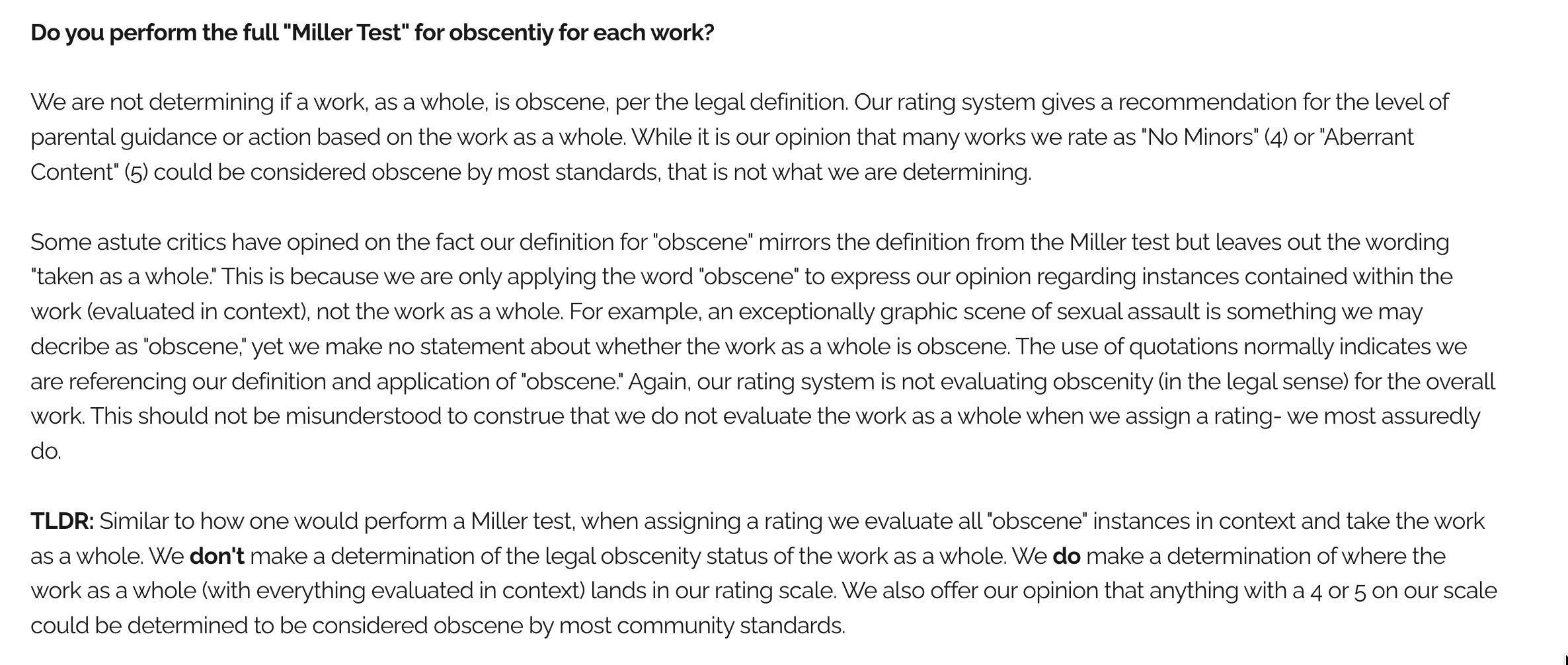

Volunteer readers review books, teasing out sentences or phrases within the texts that they do not like or agree with. They also count up swear words to create a handy little guide to how often certain words are used. Neither of these—nor their short reviews of why a book earned its rating—follow the standards set forth by the Miller Test, the prevailing standard for testing obscenity. Indeed, that doesn’t matter to them at all; they are providing these reviews as a “service” for parents.
Except as we’ve seen, these reviews are being legitimized by those of a particular political persuasion sitting on school and public library boards. It began in Volusia County, Florida, where the board wanted to “invest” in BookLooks for their district, and it continues with BookLooks being shared as a “resource” in Warren County Public Libraries (New Jersey), the Mauston Public School (WI) administration’s attempts to use it to weed classroom and school library collections, and most recently, the above-mentioned plans to use it to make book-related decisions in St. Francis Schools in Minnesota.
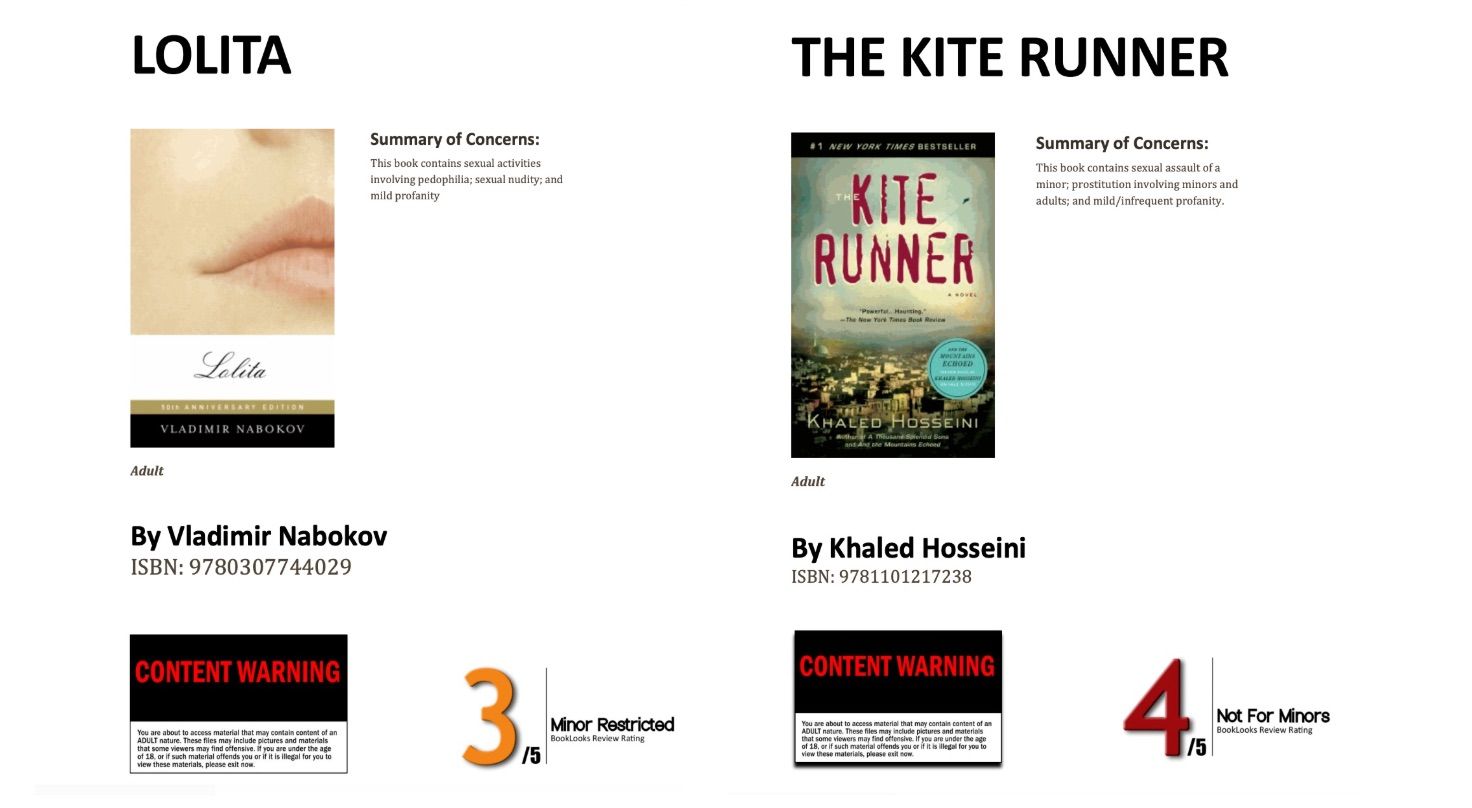

Here’s an example of two ratings on BookLooks. A book about an actual groomer—the word that gets so easily tossed around describing library workers and educators for providing diverse literature in their collections—is deemed more appropriate for minor readers than The Kite Runner.
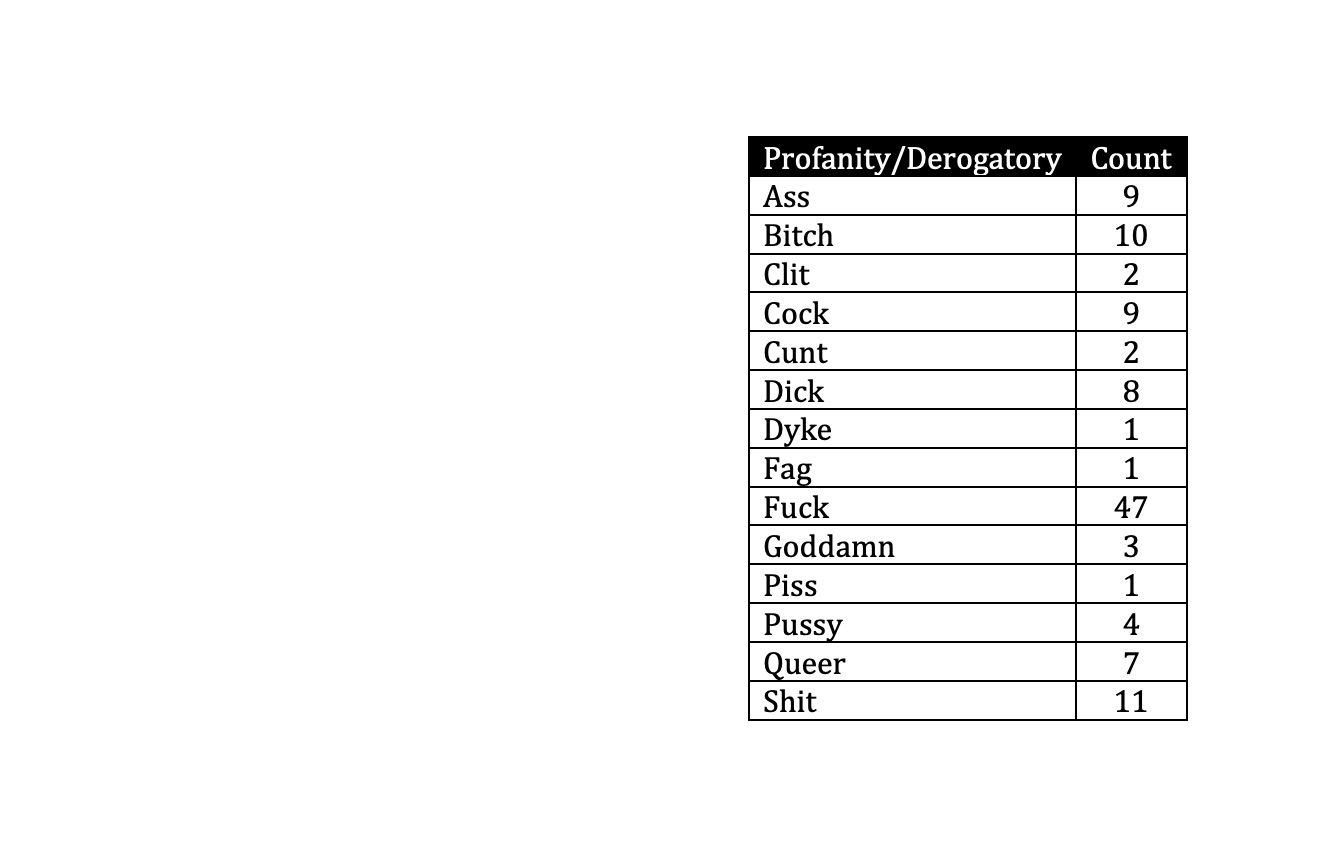

The image above is the handy count of profane and derogatory words included in Roxane Gay’s Not That Bad: Dispatches from Rape Culture. Really sit with that: instead of reading the book for what it is, a collection of essays about rape culture, volunteers for BookLooks just count up the naughty words and lay them out.
Rated Books
Owned by several “parental rights” groups, including Utah Parents United, No Left Turn in Education, and the standalone Facebook groups of LaVerna in the Library and her state-level sister pages Mary in the Library, RatedBooks.org is very similar to BookLooks in that it utilizes content ratings on a zero to five scale. It, too, creates handy little guides to sentences deemed inappropriate by volunteer readers, and it offers up far from objective views on whether or not a book should be accessible to minors.
Take Patricia McCormick’s Sold as an example. The book earns a five out of five, classifying it as explicitly inappropriate content that should be inaccessible to any minors. Here is the review.
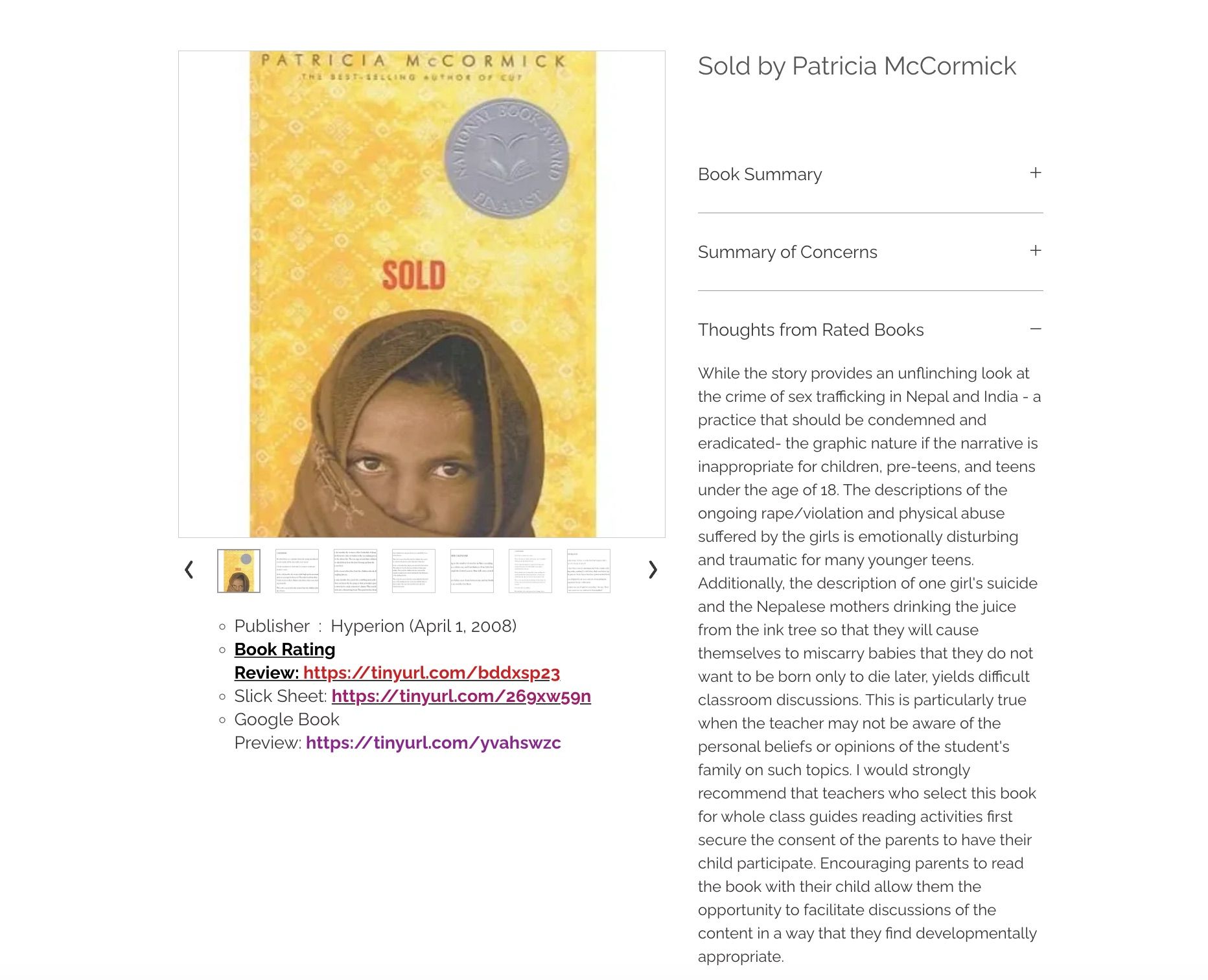

Not only is a very clear and singular agenda laid out in the review, it’s done in such a way as to be utterly patronizing to any educational professional.
[T]he description of one girl’s suicide and the Nepalese mothers drinking the juice from the ink tree so that they will cause themselves to miscarry babies that they do not want to be born only to die later, yields difficult classroom discussions. This is particularly true when the teacher may not be aware of the personal beliefs or opinions of the student’s family on such topics.
What’s especially interesting about this review is that it’s coming from the same party of people who continue to believe that America has a human trafficking problem that is mathematically impossible to have and that supports propaganda films that “expose” this issue, like Sound of Freedom.
When it’s brown kids in another country, though, it’s downright aberrant content.
Take Back the Classroom
The brainchild of Project of The Parental Rights Council and The Kitchen Table Activist (itself affiliated with the Capitol Resource Institute, a public policy institute focused on “parental rights” and “educational freedom”), Take Back the Classroom offers yet another database of books with ratings that they deem inappropriate. Take Back the Classroom essentially takes what BookLooks and RatedBooks does—reviews with cherry picked passages parents can perform at local school and library board meetings—and then offers a look at where those books are in schools across the US. This second part is what Facebook groups like Mary in the Library mentioned above try to do.
Take Back the Classroom is a newer resource and is trying to differentiate itself by providing actual pictures of the books and so-deemed offensive passages while making it even easier for parents to complain to schools. This is paternalism packaged as a helpful guide to local-level activism; we’ll tell you what to do and you’ll be able to do it without having to think at all whether or not it is a thing you want or should be doing!
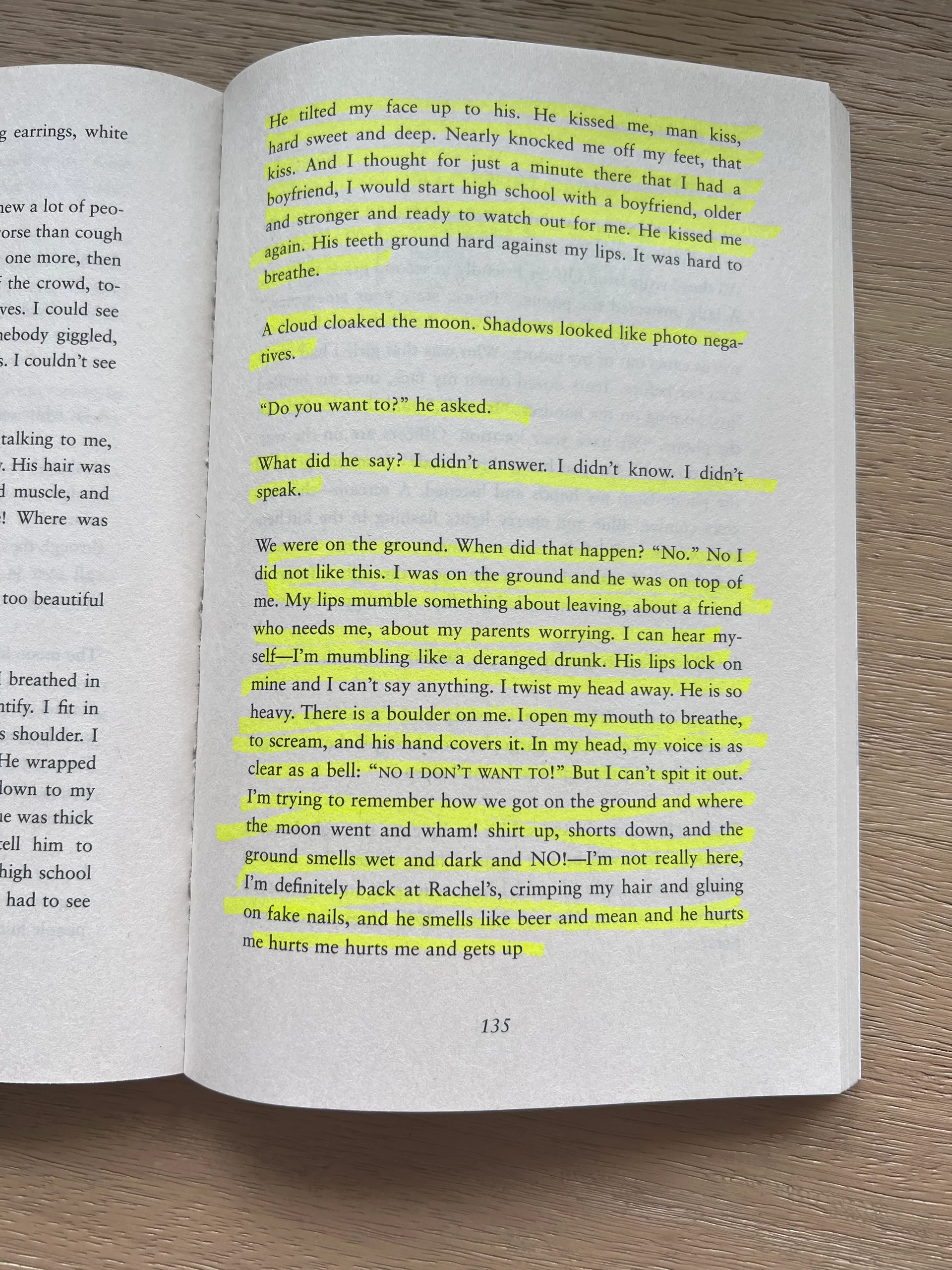

With zero elaboration, zero context, and zero description to give meaning to this “review” of Speak by Laurie Halse Anderson, users of the website are presented with a highlighted sexual assault scene from the book. A scene where the protagonist makes it clear she is being assaulted and saying no. A scene that is in no way graphic or obscene but scary and a lived reality for too many teens today.
This is what concerned parents are encouraged to take to their schools—perhaps in Bermudian Springs School District or Central York School District in Pennsylvania or Avon Public Schools in Connecticut, where those books are identified as being part of the available materials.
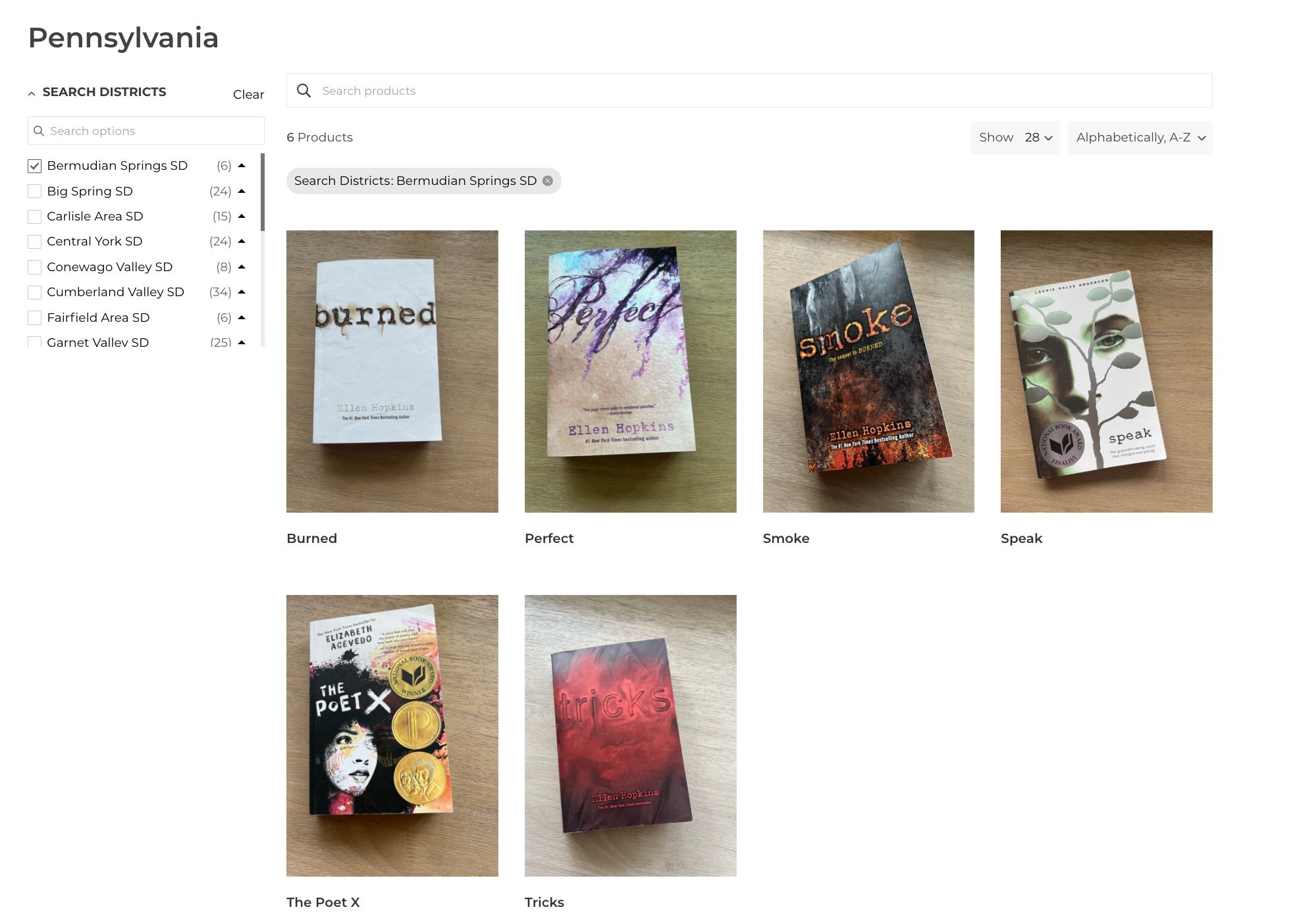

Books and their locations are submitted via the website. The folks behind this review site have made their agendas pretty clear through this handy little publication that also teaches parents how to perform their moral panic at local boards. Keep pulling those passages out of context while claiming there is porn via “proof” that is a small passage about sexual assault in a book that is about what happens to victims who are assaulted in a society that would prefer they don’t talk about it at all.
Screen It First
Why rely on a group like Moms For Liberty or No Left Turn in Education to do your book reviews for you when you can instead be part of the crowdsourced project that identifies inappropriate books nationwide? Welcome to Screen It First, which purports to help parents identify naughty books. Among the categories that reviews screen for? Foul language, violence, sexual content, and LGBTQ+ content.
The “it’s not about gay people!” nonsense spouted is pretty hard to turn from when LGBTQ+ content is one of the review categories.


Screen It First reviews anonymously, and it compiles those anonymous passages of inappropriate content for users to access. What a wealth of information for book banners to have access to—screenshot upon screenshot of material that is pulled out of context and shared with anonymity.


It’s nice that they take a step back from any connection to book banning or censorship, despite the fact they are building a database that makes it easy for anyone to engage in just those activities. If it were about “informed choices” and “age appropriateness,” then there would be no call out category of LGBTQIA+ in the reviewing process, as any content in that category would be age-appropriate in books written for its respective age group.
Books don’t just appear on shelves but go through several rounds of review, screening, editing, and more before they get there.
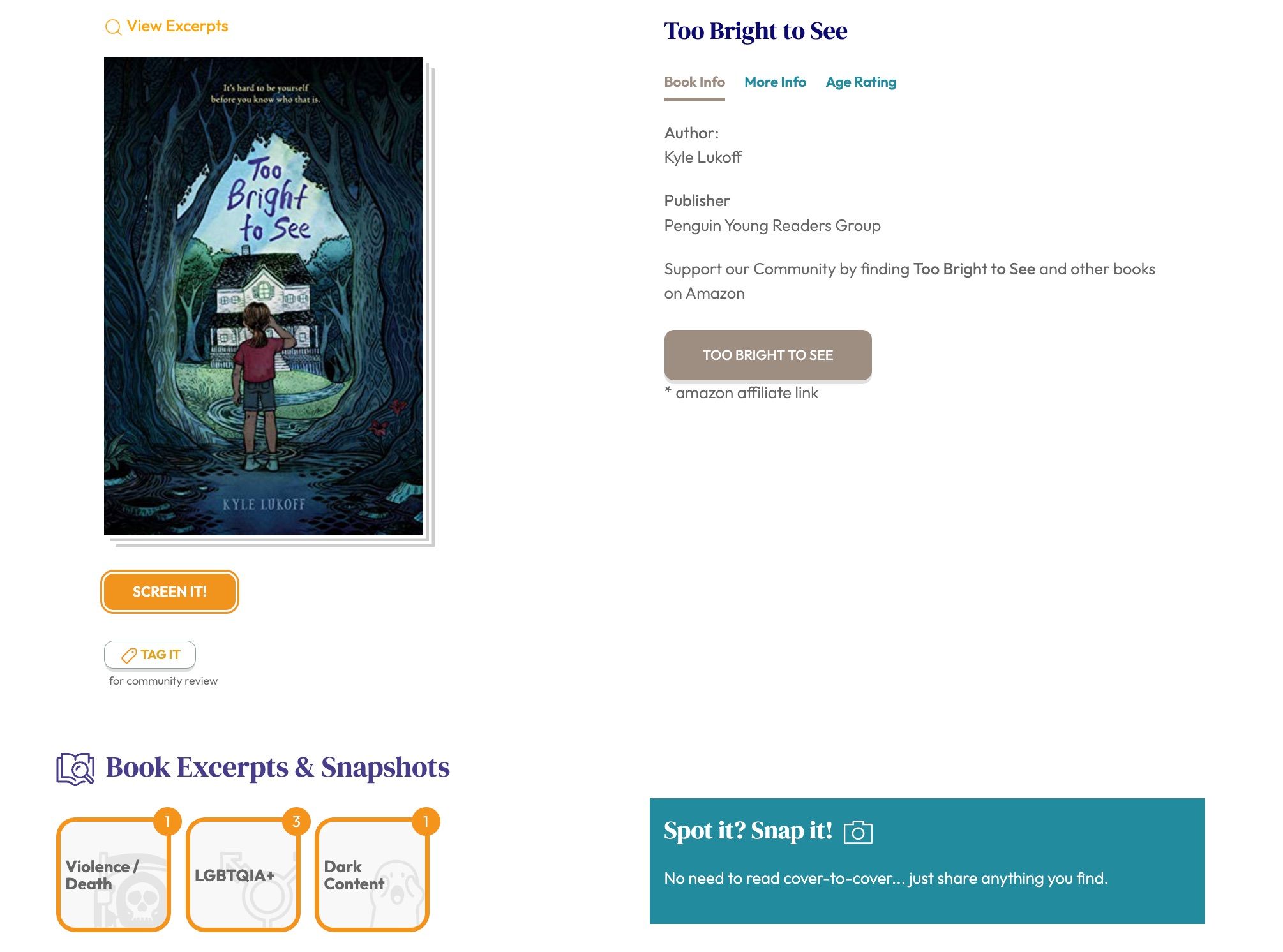

No need to read cover-to-cover, folks. Just share anything you find so that we can create a list of LGBTQIA+ books for folks to complain about as quickly and easily as possible. It’s too hard for them to do the work themselves.
Here’s one of the offending scenes from Too Bright to See and the explanation for it. Ready?
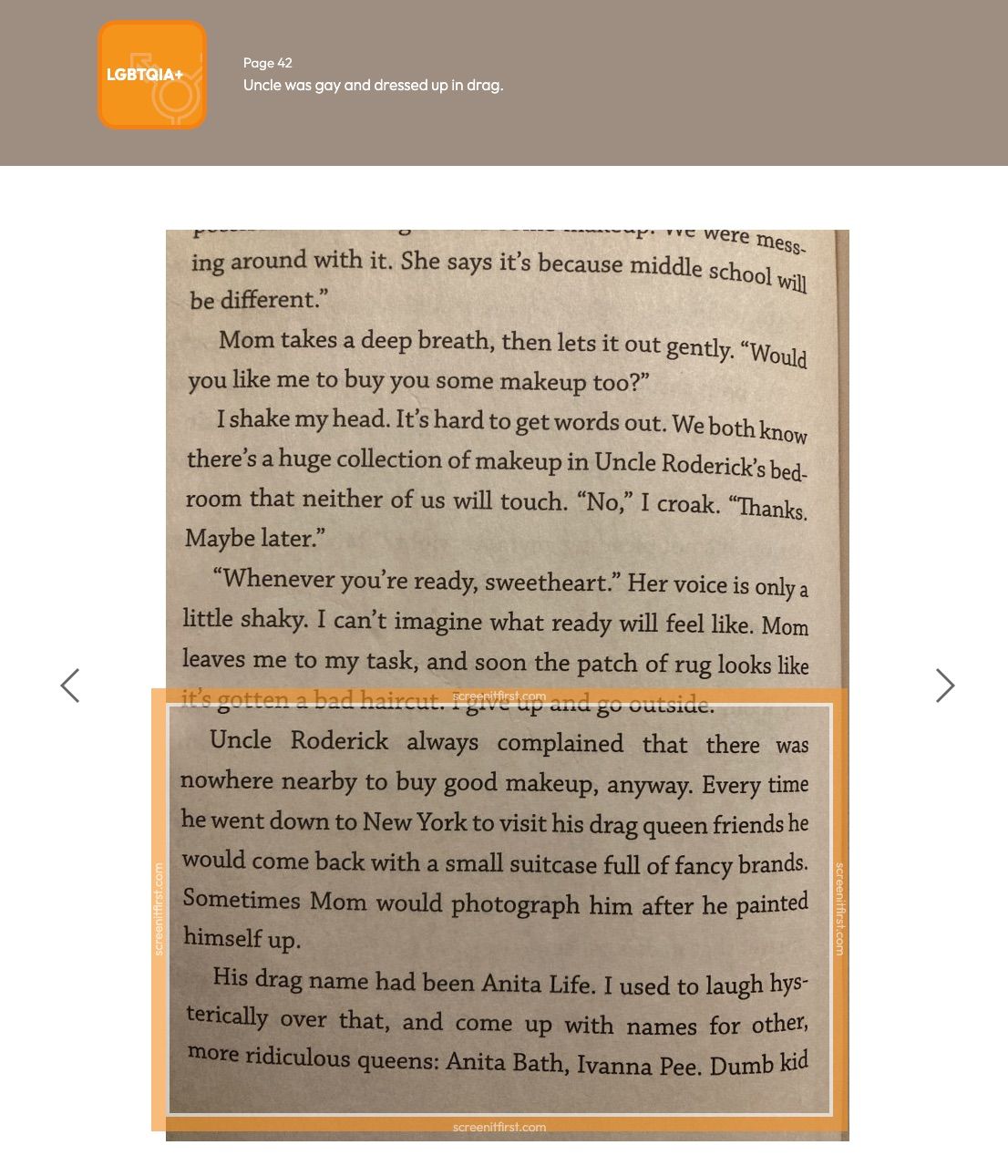

“Uncle was gay and dressed up in drag.”
We The People/Bruce Friedman
Proud serial book banner Bruce Friedman from Clay County, Florida, maintains one of the longest book target lists in the country. It’s longer and more robust than either the group he’s affiliated with—No Left Turn—and the one that captures the most coverage, BookLooks.
We The People’s “inappropriate books” list is, as of writing January 2025, over 7,000 books long. You can access a copy of that list here, but it is frequently updated.
Bruce is the top book banner in Florida, which is impressive given the competition from Escambia County’s Vicki Baggett. His document includes his concerns about the books, and for titles he has challenged and/or successfully had banned in Clay County, he simply uploads his documents so that other people can copy-paste in their own districts.
Here’s what his notes have to say about Body Talk: 37 Voices Explore Our Radical Anatomy, one of the three anthologies that I edited and he subsequently decided to seek bans for.




Illustrations of non-cis people—actual bodies that actual people have—was why the book was banned in Clay County. “An easy win.”
Bruce was not successful in trying to get (Don’t) Call Me Crazy banned last year, and I’ll be here waiting to see what happens with Here We Are: Feminism for the Real World. He’ll have to wait a bit to challenge that one, given that he’s been limited to the number of books he can bring complaints about to the board.
(If it weren’t retaliation, then the link to my first story about Bruce’s hobby of going to Clay County School Board meetings to complain about books wouldn’t have led to all three of my books *suddenly* showing up on this list, nor would he have needed to include a link to said piece).
Additional Lists & List Compilations
Several lists developed more locally include home-grown reviews and ratings, as well as pull from bigger review databases like BookLooks and RatedBooks. Here are a few more for your reference:
In putting this list together, I stumbled upon another interesting resource. While it is not being used to ban books yet, the capacity is there, and more, there are plenty of copyright-related issues that arise. That site is Sift Books, which will edit audiobooks to allow listeners to skip anything they might deem “inappropriate.” There is little information about the individuals behind the site, though they do note that it can take up to a month for a requested title to be redacted appropriately. That word there, redacted, is what’s happening here and it’s one of the four Rs of book censorship. Even if the book isn’t outright banned, it can still be censored in ways like this.
Sift Books might seem innocuous in its infancy. But how long until this site becomes where people turn to make decisions about what should or shouldn’t be banned and/or to seek subscriptions for items already within a collection to redact materials for library users?
Book Censorship News: January 10, 2025
- Let’s Talk About It: The Teen’s Guide to Sex, Relationships, and Being a Human was banned from Mobile Public Library (AL).
- Cache County Schools (Utah) will not be removing I Know Why the Caged Bird Sings nor The Handmaid’s Tale from the district. Recall that in Utah, every district’s decision on banned books is even more vital than in most other places—if three districts remove a book, every single district in the state must follow suit.
- Two trustees at Eagle Library (ID) were removed from their positions last fall and it turns out that’s because they were pushing for book bans beyond their power. This included using—surprise!—BookLooks as some sort of authority on whether or not books should be in the public library they were part of governing.
- “The proposed policy would only allow a limited number of displays, such as the American flag, state flags, university insignias (in approved locations) and items pertaining to a “temporary unit of study in the curriculum.” This would not only result in the removal of safe space posters with LGBTQ+ flags, but also much of what a teacher displays in the classroom.” This is Little Miami, Ohio, schools.
- New Hampshire legislators are pursing a “parental rights” bill that would let folks more easily ban books they don’t like.
- This story is paywalled, but Spanish Fort Public Library (AL) is struggling with book relocations, primarily of LGBTQ+ books, from children’s areas to teen areas. This is coming via the library board, who has also made it impossible to locate board meeting agendas or minutes, as well as library policies. If you’re in Spanish Fort, please write the library board.
- Rochester, Minnesota’s public school superintendent removed the children’s book The Rainbow Parade from elementary school shelves. Why? “Nudity.” Remember Minnesota is an anti-book ban bill state.
- The Glass Castle will remain on shelves in Edmond, Oklahoma, high schools.
- “Many of the 42 workers who manage elementary school libraries in the Salem-Keizer School District said they’re frustrated that their jobs have been reduced this school year to little more than babysitting. The number of classes that library workers supervise doubled in some elementary schools this year to accommodate an increase in prep time for teachers.” This story out of Salem, Oregon, is a must-read, and there’s the bit, too, about how the district has no certified librarians after laying them all off in 2011. Not censorship news per se, but it is about the ways library workers are treated as secondary.
- Oh, it’s the book banners who got to have their voices heard over the board makeup at Athens-Limestone Public Library (AL).
- Neither Gender Queer nor an illustrated children’s edition of the Bible will be banned from Boise Public Library (ID). The library is, however, still wrestling with what to do about Idaho’s draconian book ban bill in the meantime.
